OCG 2019.10 Metagame (1 Oct – 31 Dec 2019)
The OCG 2019.10 Limit Regulation placed some heavy hits on Dragon Link, and coupled with the release of Extra Pack 2019, the metagame saw a big shift.
Compiled from a total of 648 top-placing decks from 91 competitive tournaments held in Japan, Asia, China and Korea here is the final metagame breakdown of the OCG 2019.10 format.
Metagame Breakdown
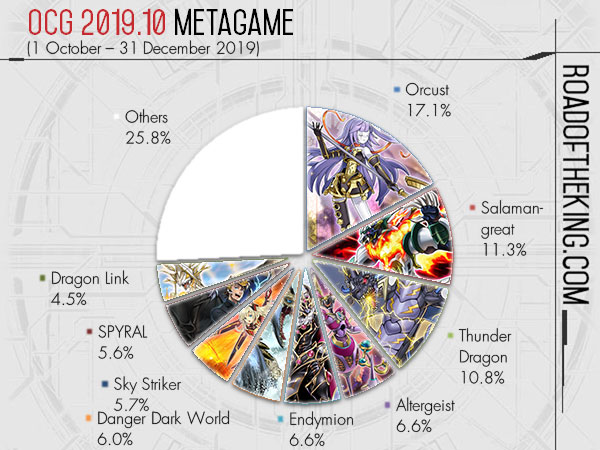
- 111 Orcust (87 Orcust, 18 Danger Orcust, 2 Danger HERO Orcust, 2 Grass Danger Orcust, 1 Grass Danger Dinosaur Orcust, 1 Mekk-Knight Orcust)
- 73 Salamangreat (72 Salamangreat, 1 Grass Salamangreat)
- 70 Thunder Dragon (64 Thunder Dragon, 4 Invoked Thunder Dragon, 1 Brilliant Thunder Dragon, 1 Grass Danger Thunder Dragon)
- 43 Altergeist
- 43 Mythical Beast Endymion
- 39 Danger Dark World
- 37 Sky Striker
- 36 SPYRAL (27 SPYRAL, 5 Grass HERO SPYRAL, 2 Grass Danger SPYRAL, 1 Grass Danger HERO SPYRAL, 1 HERO SPYRAL)
- 29 Dragon Link
- 21 Subterror
- 20 Magician
- 20 Zefra
- 13 Trickstar (12 Trickstar, 1 Danger Trickstar)
- 9 HERO
- 9 Lunalight (5 Lunalight, 2 Danger Lunalight, 1 Grass Danger Lunalight, 1 Grass Danger Orcust Lunalight)
- 8 Invoked (6 Invoked, 1 Kaiju Invoked, 1 Mekk-Knight Invoked)
- 8 Trickstar Orcust
- 7 Cyber Dragon
- 6 Gizmek Orochi Da Eiza
- 5 Infernoid (3 Infernoid, 2 Grass Infernoid)
- 4 Burning Abyss (3 Burning Abyss, 1 Phantom Knights Burning Abyss)
- 3 Magical Musket
- 3 Mekk-Knight
- 3 Meta Beat
- 2 Gizmek Orochi Zeroboros
- 2 Madolche
- 2 Six Samurai
- 2 Tenyi Yang Zing
- 2 Train
- 2 True Draco
- 2 World Chalice
- 1 Ancient Warriors
- 1 Aslla Piscu The World FTK
- 1 Dragonmaid
- 1 Evil Eye
- 1 Fairy Tail
- 1 Fluffal
- 1 Gizmek Kaiju Luna
- 1 Mekk-Knight Artifact Traptrix
- 1 Mekk-Knight Treasure Panda
- 1 Dinosaur Rokket
- 1 Rokket
- 1 Sekka Danger Kaiju Luna
- 1 Shaddoll
- 1 Unchained
Orcust
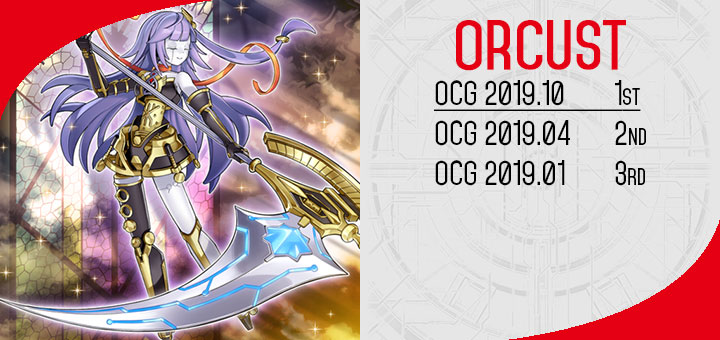
Looking to replicate the success in the TCG, Danger Orcust was the dominant popular build at the start of the format. On the surface, Danger seems to be quite rewarding when discarding Orcust monsters, but the OCG had Maxx “C” that made it much harder for Danger to go off without giving the opponent too much card advantage.
The rising popularity of Nibiru, the Primal Being saw many players shifting it from the Side Deck to the Main Deck, making Danger monsters and their Special Summons even much less desirable. Orcust players started reducing the amount of Danger monsters and eventually cutting them altogether.
Using I:P Masquerena with the Topologic Link Monsters would become the predominant strategy for Orcust. In this build, Orcust only perform a minimal of Special Summons to bring out Galatea, the Orcust Automaton and using its effect to set Orcustrated Babel and then ending with I:P Masquerena. This makes it much harder for the opponent to take out big threats with Nibiru, the Primal Being as the threat is only Link Summoned on the next turn using I:P Masquerena‘s effect.
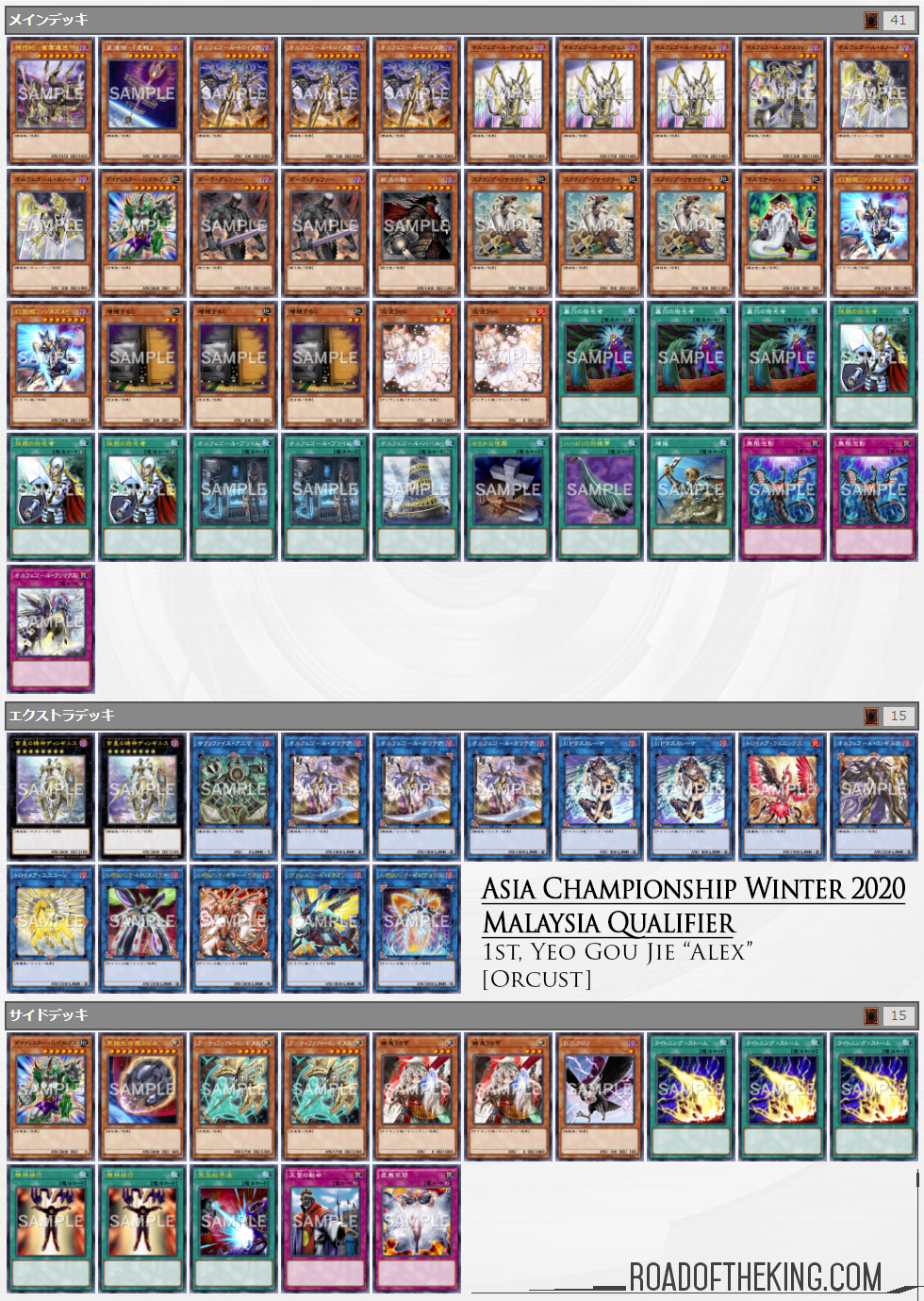
OCG 2019.10 → OCG 2020.01 Limit Regulation changes:
- Orcust Harp Horror 3 → 2
- Galatea, the Orcust Automaton 3 → 2
- Mathematician 1 → 2
The OCG 2020.01 Limit Regulation only weakened Orcust slightly, and they continue to be a top contender in the new format.
Salamangreat
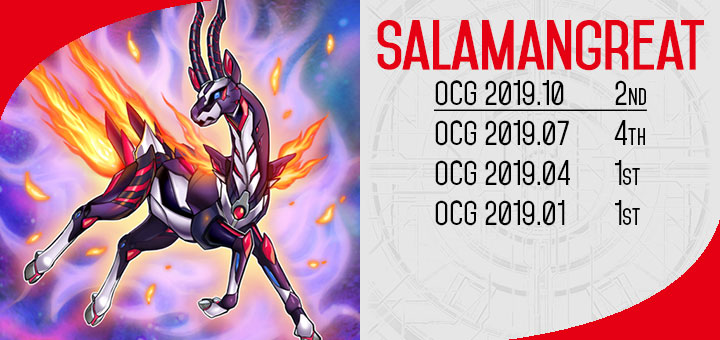
Salamangreat had a difficult time going as Nibiru, the Primal Being could disrupt their opening combo before they could reach Salamangreat Sunlight Wolf and start generating card advantage. Eventually they found a solution in running 2 or 3 Crossout Designator accompanied by 1 Nibiru, the Primal Being in the Main Deck.
Running 3 Mind Control in the Main Deck became a popular strategy for Salamangreat as it was a reliable answer to Thunder Dragon Colossus. The release of Gizmek Kaku, the Supreme Shining Sky Stag gave them another out to Thunder Dragon Colossus.
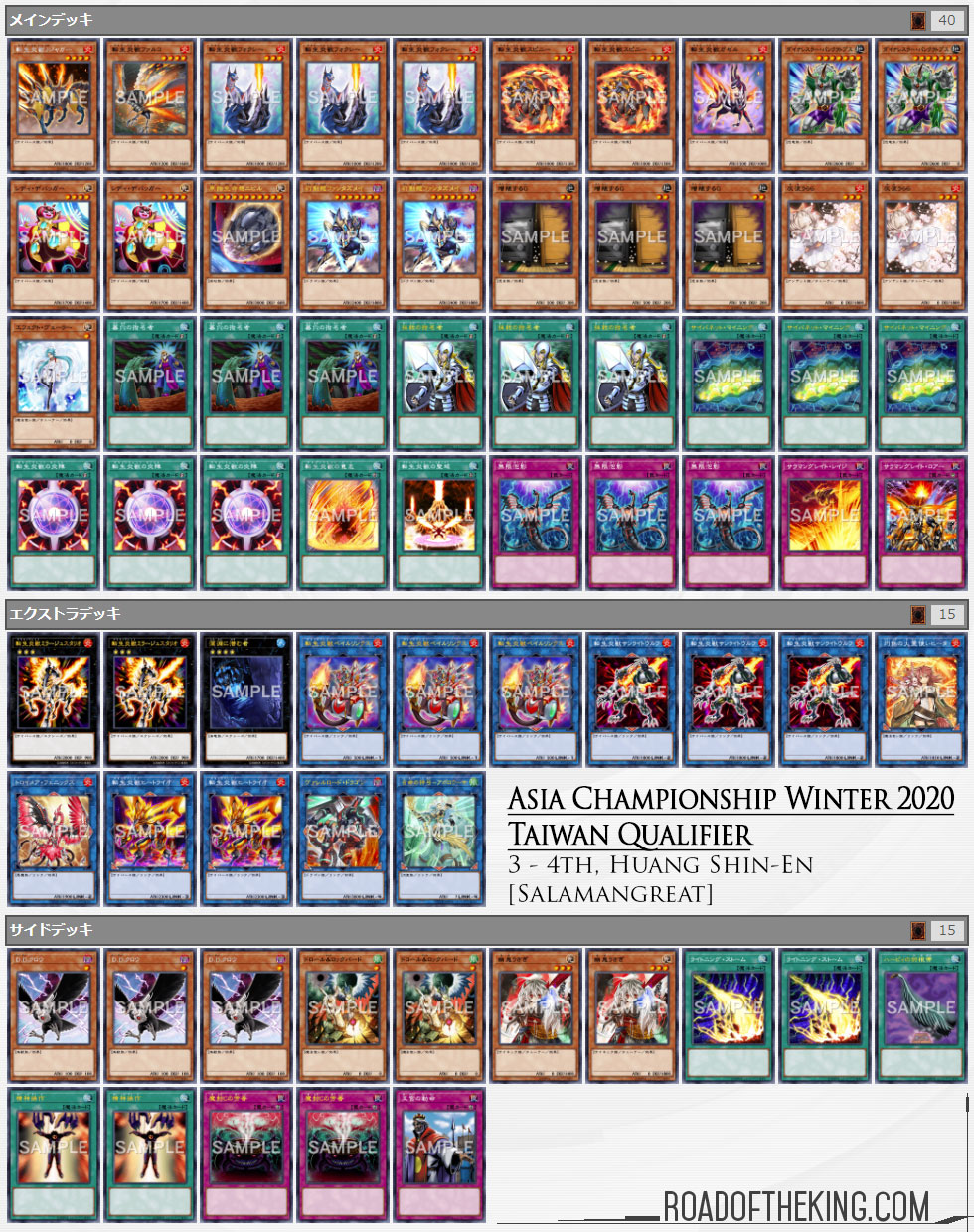
OCG 2019.10 → OCG 2020.01 Limit Regulation changes:
- Salamangreat Circle 3 → 2
- Mind Control 3 → 2
The OCG 2020.01 Limit Regulation reduced Salamangreat’s consistency by another notch, but they have mostly fallen off due to being unable to compete against Red-Eyes Dark Dragoon.
Thunder Dragon
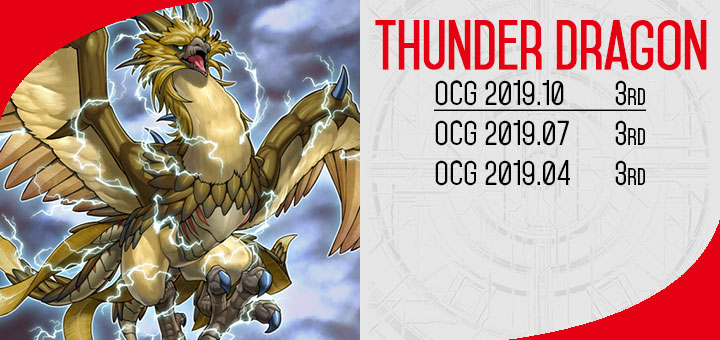
The popularity of Nibiru, the Primal Being in the early OCG 2019.10 format saw a decline in Combo decks, as players switched over to Beatdown decks. This allows Thunder Dragon quickly to quickly rise to the top as they could play around Nibiru, the Primal Being, and still open with Thunder Dragon Colossus.
Thunder Dragon briefly held onto the top spot, but was swiftly overwhelmed by Orcust, one of their bad matchups. Despite being suppressed by Orcust, Thunder Dragon continues to fluctuate near the top.
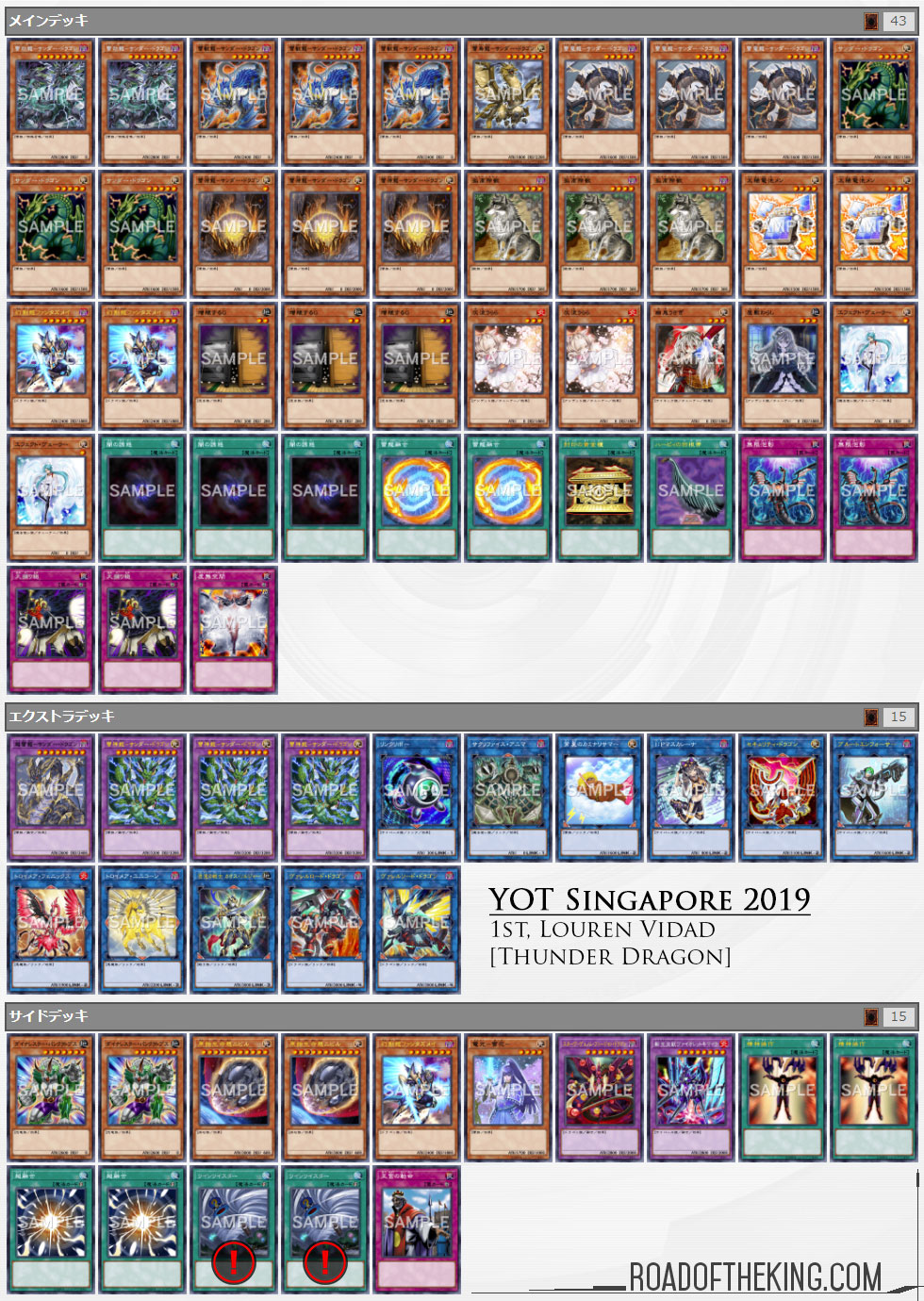
OCG 2019.10 → OCG 2020.01 Limit Regulation changes:
- Thunder Dragonroar 3 → 2
- Allure of Darkness 3 → 2
The OCG 2020.01 Limit Regulation took another swing at Thunder Dragon by hitting their consistency. Thunder Dragon may be still decent, but they are struggling to keep up in the new format.
Conclusion
The biggest impact on the OCG 2019.10 metagame is without a doubt Nibiru, the Primal Being.
The initial reaction to Nibiru saw a sharp decline in Combo decks, giving rise to Beatdown decks. Against Beatdown decks, ‘hand traps’ are much less desirable, and this opened up the metagame for Endymion running zero ‘hand traps’ to shine.
However, Combo decks are far from dead, as they turned to Outer Entity Azathot to prevent Nibiru dropping on them. Once Azathot has shutout all ‘hand traps’, Danger Dark World and SPYRAL could go all out with their combos, setting up multiple negations and discarding the opponent’s hand with Topologic Gumblar Dragon.
The OCG 2019.10 was a very diverse metagame, having over 8 different decks that were constantly topping across various tournaments.
If you enjoyed these Quarterly Metagame Reports, do consider supporting Road of the King on Patreon. Cheers!

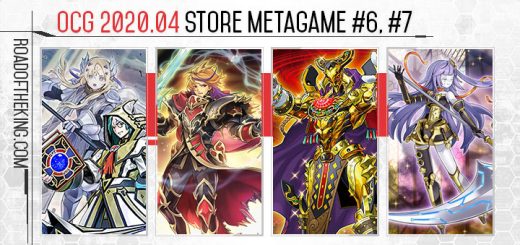

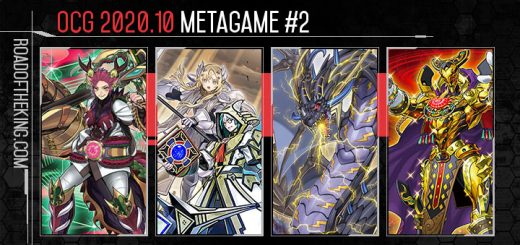
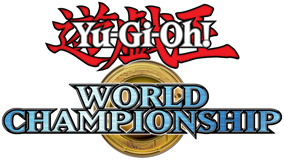


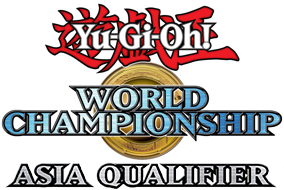
Thunder Dragon section: you mention early 2019.07 format – i believe you mean 2019.10. Then there’s a sentence later: “This allows T.D. quickly to quickly rise”.
That’s all. Great breakdown as always.
Corrected. Thanks!
looking at almost every breakdown, noone even runs nibiru. atmost 1 copy in the side in case someone runs it against them for crossout. doesnt sound like a big impact at all
That is looking at Nibiru from just the surface level, but Nibiru has affected the metagame all the way down to the gameplay and combo level.
The implication of Nibiru results in top decks needing to be able to play around Nibiru or stop Nibiru. In a way Nibiru has become a gatekeeper, and only decks that can power through Nibiru becomes the top of the metagame. Beatdown and Control decks have to setup a powerful opening board by the 4th summon, while Combo decks have been refined to reach Azathot or Apollousa on the 5th summon, just in time to deny Nibiru.
Since these top decks can power through or halt Nibiru, this caused players to cut down on Nibiru because Nibiru is less effective against them. But not be mistaken that Nibiru is not impactful, the rest of the lower tier decks are badly wrecked by Nibiru, which is why they are not among the top decks. Even then the threat of Nibiru still forced the top decks to keep 1 copy of Nibiru for Crossout Designator.
Although the amount of Nibiru being played is not as pervasive, but its existence has warped the metagame to play around it.